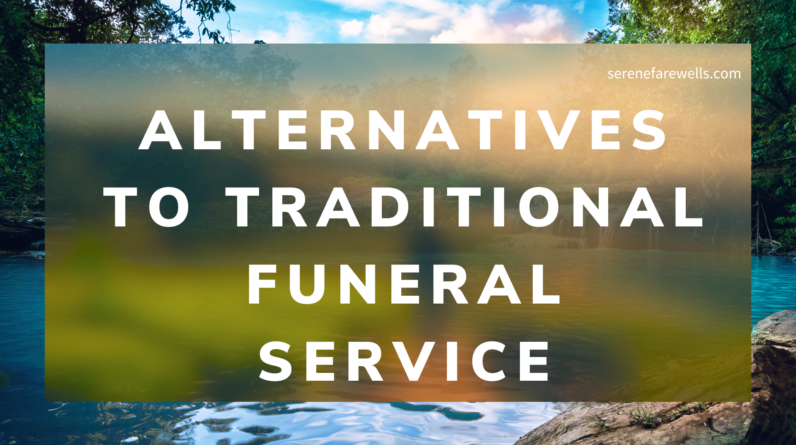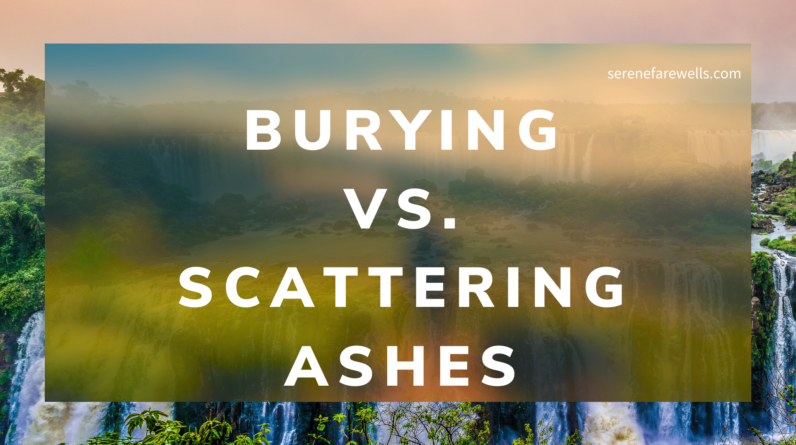
Let’s explore the various alternatives to a traditional funeral service that can provide a unique and personalized way to say goodbye to your loved ones. From eco-friendly options like green burials and biodegradable urns to virtual memorials and celebration of life ceremonies, there are plenty of alternatives available to honor and remember the departed in a meaningful and heartfelt manner. Discover the possibilities that go beyond the conventional funeral service, allowing you to create a farewell as unique as the life that was lived.
1. Green or Natural Burial
1.1 Definition of Green or Natural Burial
Green or natural burial refers to a method of laying the deceased to rest that emphasizes environmental sustainability and aims to minimize the impact on the earth. Unlike traditional burials that involve embalming, synthetic materials, and non-biodegradable caskets, green or natural burials focus on returning the body to the earth in its most natural form.
1.2 Benefits of Green or Natural Burial
Green or natural burial offers several benefits both for the deceased and the environment. Firstly, it allows the body to decompose naturally and become one with the soil, which supports the cycle of life. This process is free from toxic chemicals and reduces the ecological footprint associated with traditional burials.
Additionally, green burial sites often serve as protected natural areas, promoting biodiversity and providing opportunities for nature conservation. Compared to traditional cemeteries, which require maintenance and resources, green burial grounds are typically simpler and less costly to manage.
1.3 Examples of Green or Natural Burial Alternatives
There are several alternatives to traditional burial practices that embrace the principles of green or natural burial. One such method is direct earth burial, where the deceased is interred in a biodegradable casket or wrapped in a shroud, without the use of embalming fluids. Another option is a burial at sea, where ashes or the body itself is deposited into the ocean, providing a peaceful and environmentally friendly resting place. Additionally, some individuals choose to have a memorial tree planted in their honor, with their ashes used as fertilizer to nourish the tree as it grows.
2. Cremation
2.1 Definition of Cremation
Cremation is a process that involves the transformation of the deceased body into ashes through the application of intense heat. This method has gained popularity in recent years as an alternative to traditional burial, as it offers a more versatile and environmentally conscious approach to memorialization.
2.2 Types of Cremation
There are different types of cremation processes available, each offering unique options for memorialization. The most common method is traditional cremation, which involves placing the body in a specialized furnace and reducing it to ashes. Water-based or aquamation cremation, also known as alkaline hydrolysis, is another option that utilizes a mixture of water and potassium hydroxide to break down the body’s tissues.
2.3 Benefits of Cremation
Cremation offers several benefits that make it an attractive alternative to traditional burial. Firstly, it provides flexibility in terms of memorialization, allowing loved ones to choose from a wide range of options such as scattering the ashes, placing them in an urn, or incorporating them into jewelry or artwork. Additionally, cremation requires less physical space compared to traditional burials, which is particularly advantageous in areas where land availability is limited.
From an environmental standpoint, cremation can be a greener option than traditional burials. Modern cremation techniques have become more energy-efficient, and some facilities even offer carbon-neutral cremations, offsetting the carbon emissions generated during the process.
2.4 Creative Uses for Ashes
The ashes resulting from cremation can be utilized in various creative and meaningful ways to honor the memory of the deceased. Some individuals choose to scatter the ashes in a special location that held significance to the deceased, such as a favorite vacation spot or a natural setting they cherished. Others opt to divide the ashes among family members, who may choose to store them in a decorative urn or incorporate them into jewelry or artwork. Another increasingly popular option is the creation of “memorial diamonds” by extracting carbon from the ashes and transforming it into a certified gemstone.
3. Memorial Service
3.1 Definition of a Memorial Service
A memorial service is a gathering held to honor and remember a deceased person’s life. Unlike traditional funeral services, which typically involve the body of the deceased present, memorial services focus on celebrating the person’s life and the impact they had on others.
3.2 Benefits of a Memorial Service
Memorial services offer numerous benefits for both the grieving family and the attendees. They provide an opportunity to gather with loved ones and share memories, stories, and anecdotes, fostering a sense of unity and support. Unlike funerals that often have a somber atmosphere, memorial services can be tailored to reflect the unique personality and interests of the deceased, creating a more personalized and uplifting experience.
Memorial services also allow for more flexibility in terms of timing and location. Families can choose to hold the service at a meaningful location, such as a park, beach, or the deceased’s favorite restaurant. Additionally, memorial services can be held weeks or even months after the person’s passing, allowing family and friends more time to make arrangements and travel if needed.
3.3 Unique Approaches to Memorial Services
In addition to traditional memorial services, many individuals are choosing to add unique elements to make the event more meaningful and personal. These may include incorporating the deceased’s favorite hobbies or interests into the service, such as displaying artwork, playing their favorite music, or arranging a themed event based on their passions. Some families opt for interactive memorial services, where attendees actively participate in activities that were important to the deceased, such as planting trees, painting, or engaging in charitable work.
3.4 Virtual Memorial Services
With the advancements in technology and the rise of online communication, virtual memorial services have become a viable option for those unable to gather physically. These online services allow family and friends from around the world to come together virtually to share stories, memories, and condolences. Virtual platforms offer features such as video streaming, virtual guestbooks, and chat functions, providing a meaningful and inclusive experience for all involved.
4. Body Donation to Science
4.1 Definition of Body Donation to Science
Body donation to science, often referred to as anatomical donation, is the decision to donate one’s body for medical education, research, or other scientific purposes after death. This selfless act allows medical professionals, students, and researchers to further their understanding of the human body and contribute to advancements in medicine and healthcare.
4.2 Benefits of Body Donation to Science
Body donation to science offers numerous benefits to both the donor and society as a whole. Firstly, it allows individuals to leave a lasting legacy by directly contributing to scientific knowledge and education. Donors have the satisfaction of knowing that their body will be used to train future doctors, surgeons, or researchers, potentially leading to medical breakthroughs that benefit others.
From a societal standpoint, body donation provides an essential resource for medical education and research. It enables medical schools and research institutions to have a steady supply of cadavers for educational purposes and improves the accuracy of medical procedures and developments.
4.3 The Process of Donating Your Body to Science
The process of donating one’s body to science typically involves pre-registration and making arrangements with a body donation program or institution. Individuals interested in body donation should research reputable organizations that adhere to ethical and legal guidelines. Once registered, donors are often provided with a wallet card or other documentation to ensure their wishes are known and can be easily accessed upon passing.
After the individual’s death, the responsible party or next of kin contacts the chosen donation program, and arrangements are made for the body’s transportation to the respective institution. It’s important to note that not all bodies are suitable for donation, as various factors such as the cause of death or certain medical conditions may pose limitations.
4.4 Organizations and Programs for Body Donation
There are several reputable organizations and programs that facilitate body donation to science. These organizations work closely with medical schools and research institutions to ensure the ethical use of donated bodies. Some well-known programs include the Anatomical Gift Association of Illinois, the University of California Body Donation Program, and the Mayo Clinic Body Donation Program. It is crucial to thoroughly research and contact potential programs to understand their specific requirements and processes before making a decision.
5. Life Celebrations and Living Funerals
5.1 Definition of Life Celebrations and Living Funerals
Life celebrations and living funerals are alternative approaches to honor and recognize a person’s life while they are still alive. These events shift the focus from mourning and grief to celebrating and appreciating the individual’s experiences, values, and accomplishments.
5.2 Benefits of Life Celebrations and Living Funerals
Life celebrations and living funerals bring numerous benefits to both the person being honored and their loved ones. These events provide an opportunity to express gratitude and love for the person’s existence and accomplishments while they are still able to participate and appreciate the recognition. It allows them to share their life stories and experiences with family and friends, fostering a sense of connection and unity.
For the loved ones attending these celebrations, the opportunity to express appreciation and spend quality time with the person before their passing can provide a sense of closure and comfort. It offers an intimate and meaningful experience that allows for the expression of love and support in a joyous and uplifting atmosphere.
5.3 Unique Ideas for Life Celebrations
Life celebrations can be as unique and personal as the individual being honored. Some ideas to make these events more special include organizing a themed gathering that represents the person’s hobbies, passions, or cultural heritage. For example, a music lover’s life celebration could feature live performances or karaoke, while an avid traveler’s event could incorporate decorations and food inspired by their favorite destinations. Another idea is to create memory jars or art installations where attendees can leave notes or personal items as a tribute to the person’s impact on their lives.
5.4 How to Plan a Living Funeral
Planning a living funeral requires thoughtful consideration and collaboration with the person being honored, as their wishes and preferences should be at the forefront. It is important to involve them in the decision-making process and discuss their desired level of involvement in the event. Working together, key elements such as the venue, guest list, activities, and theme can be determined.
Additionally, it may be helpful to appoint a designated person or group to assist with organizing and coordinating the event. They can manage logistics, send invitations, and ensure that all the necessary arrangements are made. Collaborating with loved ones, friends, and community members can be a valuable source of support, ideas, and contributions to make the living funeral a memorable and meaningful experience.
6. Home Funerals
6.1 Definition of Home Funerals
Home funerals, also known as family-directed funerals, empower families to care for their deceased loved ones at home, facilitating a more intimate and personal experience. Instead of relying solely on funeral homes and embalmers, families take an active role in preparing the body, holding visitations, and organizing the funeral service within the comforting confines of their own home.
6.2 Benefits of Home Funerals
Home funerals offer a range of benefits that can greatly contribute to the healing process for grieving families. By allowing loved ones to take an active role in caring for the deceased, home funerals provide a sense of intimacy, familiarity, and closure. Family members can participate in the washing and dressing of the body, allowing for a more personal and respectful experience. This level of involvement promotes a deeper connection and understanding of the death process, fostering a healthier grieving process.
Apart from the emotional benefits, home funerals can also be more cost-effective than traditional funeral services. Families can save money by eliminating certain professional services, such as embalming or transportation, which are typically associated with funeral homes. Additionally, home funerals provide an opportunity for family and friends to come together in a familiar setting, offering a more comfortable and intimate space for grieving and support.
6.3 Legal Requirements and Considerations for Home Funerals
While home funerals are legal in many jurisdictions, there are specific legal requirements and considerations that must be adhered to. Families interested in home funerals should familiarize themselves with the local laws and regulations surrounding death care. These may include obtaining the necessary permits and certificates, completing the required paperwork, and adhering to specific timelines for burial or cremation.
It is also important to communicate with local funeral homes, cemeteries, and crematoriums to ensure they are willing to accommodate the arrangements made for the home funeral. Some areas have specific guidelines regarding transportation, burial locations, or use of public facilities that need to be considered and followed.
7. Scattering Ashes
7.1 Definition of Scattering Ashes
Scattering ashes refers to the practice of dispersing cremated remains in a meaningful or desired location. It offers loved ones the opportunity to honor the deceased by releasing their ashes into the air, water, or earth, symbolizing their return to nature and allowing for a sense of connection with the deceased.
7.2 Different Ways to Scatter Ashes
There are various ways to scatter ashes, each offering a unique experience and level of personalization. One common method is aerial scattering, where the ashes are released into the air from an aircraft, allowing for a wide distribution over a large area. Water scattering involves casting the ashes onto a body of water, such as a lake, river, or the ocean, providing a serene and reflective experience. Earth scattering involves placing the ashes directly into the ground or burying them at a desired location, such as a memorial garden or a spot that held significance to the deceased.
Other creative options for scattering ashes include incorporating them into biodegradable urns that float or dissolve in water or using them as fertilizer for memorial trees or plants. Some families choose to divide the ashes among loved ones, allowing each person to scatter them in their preferred location, creating a bond and shared experience.
7.3 Legalities and Environmental Impacts of Scattering Ashes
Before scattering ashes, it is essential to research and comply with the legal requirements and regulations in the specific jurisdiction. Different regions have different laws regarding where ashes can be scattered, and it is important to obtain any necessary permits or permissions. Some locations may have restrictions on scattering ashes in public areas or have guidelines for distance from water bodies or property boundaries.
It is also important to consider the potential environmental impacts of scattering ashes. While human ashes are typically biodegradable and non-toxic, some locations may have specific guidelines to prevent potential harm to ecosystems. For example, scattering ashes directly into water bodies may be prohibited in certain areas to protect water quality and minimize ecological disturbance. It is crucial to respect the laws, regulations, and guidelines in place to ensure the practice of scattering ashes is done in a responsible and environmentally conscious manner.
8. Sustainable Burial Options
8.1 Definition of Sustainable Burial Options
Sustainable burial options involve environmentally friendly practices that reduce the ecological impact associated with traditional burial methods. These options aim to preserve natural resources, support biodiversity, and promote the long-term sustainability of burial practices.
8.2 Eco-friendly Caskets and Burial Products
One aspect of sustainable burial options is the use of eco-friendly caskets and burial products. Traditional caskets are often made from non-biodegradable materials such as metal or hardwood, leading to a significant environmental impact. Eco-friendly caskets, on the other hand, are made from biodegradable and sustainably sourced materials such as bamboo, wicker, or cardboard. These materials break down naturally over time, allowing the body to return to the earth more harmoniously. Additional eco-friendly burial products include biodegradable urns for ashes, shrouds made from organic fabrics, and even plantable seed paper that can grow into memorial flowers or trees.
8.3 Natural Graveyard or Conservation Burial Grounds
Another sustainable burial option is the use of natural graveyards or conservation burial grounds. These burial sites embrace ecological principles, utilizing land designated for the purpose of conservation and natural preservation. Natural graveyards often have guidelines that promote sustainable burial practices, such as prohibiting embalming, requiring biodegradable caskets or shrouds, and limiting the use of headstones or markers to prevent habitat destruction. These burial grounds serve as protected areas that not only offer a final resting place for the deceased but also contribute to the preservation of wildlife, plant species, and ecosystems.
9. Online Memorials and Digital Legacies
9.1 Definition of Online Memorials and Digital Legacies
Online memorials and digital legacies are modern approaches to memorialization that utilize digital platforms to honor and remember the deceased. These virtual spaces provide opportunities for sharing memories, stories, photographs, and condolences, allowing friends, family, and community members to connect and pay tribute irrespective of physical boundaries.
9.2 Benefits of Online Memorials
Online memorials offer numerous benefits, providing a platform for perpetual remembrance and virtual connection. Families and friends can create personalized tribute pages or social media groups dedicated to the deceased, where they can share memories, photos, videos, and thoughts on special occasions or anniversaries. This virtual remembrance provides comfort and support to those grieving and creates a lasting legacy that can be accessed and cherished by future generations.
Online memorials also facilitate the gathering of condolences and expressions of support from a wider network of individuals. Friends and acquaintances from different locations can leave messages of sympathy and love, promoting a sense of community and shared mourning. These virtual spaces help bridge the gap between physical distance and provide a sense of connectedness, particularly in times when gathering in person may not be feasible.
9.3 Examples of Online Memorial Platforms
Several online memorial platforms have emerged to cater to the need for digital remembrance. These platforms provide customizable tribute pages or virtual memorial events that offer a range of features, such as photo and video galleries, guestbooks, and interactive memorial walls. Some well-known online memorial platforms include Legacy.com, GatheringUs, and ForeverMissed.com. These platforms provide intuitive interfaces designed to make it easy for families to create and manage their loved one’s online memorials while offering privacy settings and data security measures.
9.4 Creating a Digital Legacy
Creating a digital legacy is a way to ensure that one’s online presence and memories live on after their passing. This can be achieved by creating a designated digital archive or sharing access to personal online accounts with a trusted individual. Additionally, individuals may choose to compile digital albums or videos that capture their life stories, beliefs, and values, allowing future generations to understand and appreciate their legacy. Exploring and understanding the privacy settings and terms of service of various online platforms is essential to ensure that the digital legacy is preserved and shared according to the individual’s wishes.
10. Artistic and Creative Memorials
10.1 Definition of Artistic and Creative Memorials
Artistic and creative memorials involve the use of artistic expression to commemorate and celebrate the life of the deceased. These unique memorials go beyond traditional methods and incorporate various art forms, such as sculpture, painting, music, and performance, to create meaningful and personalized tributes.
10.2 Unique Ideas for Artistic Memorials
Artistic memorials offer countless possibilities for creating one-of-a-kind tributes. One idea is commissioning a custom sculpture or artwork that represents the deceased’s passions, interests, or character. This could be a statue, mural, or even a garden installation that captures the essence of their life. Another option is organizing a memorial concert or performance that features their favorite music, dances, or poetry. Encouraging attendees to contribute their own creative expressions, such as writing poems, composing songs, or staging short plays, can provide a collaborative and inclusive approach to honoring the person’s memory.
Artistic memorials can also take the form of community projects that incorporate public art to commemorate the deceased. For example, dedicating a park bench, planting a memorial tree, or creating a mural in a public space can serve as lasting reminders of the person’s impact on their community and provide comfort to both loved ones and strangers passing by.
10.3 Collaborating with Artists and Art Organizations
Collaborating with local artists and art organizations can be a valuable approach to creating artistic memorials. These individuals and groups possess the expertise and creativity to bring ideas to life and contribute unique perspectives to the memorialization process. By involving artists from various disciplines, such as painters, musicians, or actors, families can ensure that the memorial accurately reflects the personality and essence of their loved one. Additionally, connecting with art organizations or community centers can provide access to resources, venues, and opportunities for community involvement, making the artistic memorial a memorable and impactful experience for all involved.
In conclusion, there are numerous alternatives to traditional funeral services that cater to a wide range of preferences, beliefs, and values. From green or natural burials and cremation to home funerals and artistic memorials, the choices available provide individuals and families with the opportunity to reflect their uniqueness and create meaningful experiences that celebrate life. Whether it’s through sustainable practices, virtual remembrance, or creative tributes, these alternatives pave the way for a more personalized and environmentally conscious approach to memorialization.






